Protecting nonstructural components from earthquake damage
In earthquake-prone areas, proper design and engineering make sure buildings stay structurally sound during a seismic event. But earthquakes damage more than just piers and beams, so it’s important to protect a building’s nonstructural components, including the mechanical, electrical, plumbing, and fire protection systems (sometimes abbreviated MEP-F). Seismic protection for ductwork, plumbing, and other infrastructure is essential for both financial and life safety reasons.
QRFS explained the code requirements and technologies involved in seismic protection of fire sprinkler systems in our recent series. In this article, we dig into seismic protection issues, technologies, and some code requirements for MEP-F elements, including:
- The consequences of not protecting nonstructural components
- When seismic protections are needed
- Technologies for seismic protection
- Some special considerations for HVAC, electrical systems, and pipe
Nonstructural earthquake damage has financial and life safety consequences
Financial losses and nonstructural damage
Damaged infrastructure has financial costs in three ways: the expenses of repairing the equipment, cleaning up the damage, and the lost function of the building. Especially in an industrial building, the cost of replacing HVAC, plumbing and other piping, electrical systems, and fire sprinkler systems can exceed the cost of the entire structure.
The secondary damage alone—water damage from broken pipes, chemical spills, a fire caused by exposed wires and ruptured natural gas lines, etc.—can create an enormous financial impact. And broken nonstructural elements can render the building completely useless. Without plumbing, ventilation, electricity, and fire protection, it’s difficult to do any work. And the authority having jurisdiction (AHJ) may shut the building down when enforcing building and life safety codes.
Life safety concerns and nonstructural elements
Earthquake damage to MEP-F components also threatens safety. The increased risk of fire (caused by broken electrical equipment or ruptured gas lines) combined with nonfunctional fire suppression systems is one example of this. Unsecured heavy equipment—for instance, a fan in the ductwork—can fall, creating another major hazard. Even HVAC can be essential to life safety, such as when it is needed to clear away smoke or provide hospital ventilation. Piping systems may transport hazardous materials, and containment failure is especially dangerous.
When do HVAC, electrical, and piping systems need seismic protection?
On the topic of seismic protection, building codes and emergency management organizations—most notably, the Federal Emergency Management Agency (FEMA) and the International Building Code (IBC) defer to one authority—the American Society of Civil Engineers (ASCE). ASCE’s standard, Minimum Design Loads for Buildings and Other Structures (ASCE 7, 2010 edition), gives instructions for the seismic protection of nonstructural elements.
One area where ASCE 7 sets the standard is determining when a structure and its infrastructure need seismic protections. Obviously, not all buildings need to be protected from earthquakes.
Seismic design categories
ASCE 7 groups buildings (and their nonstructural elements) into seismic design categories (SDC). These categories range from A to F (A having the least concern and F the most) and take into account anticipated ground acceleration (obtained from US Geological Survey maps) and occupancy category. The occupancy category ranges from I to IV and describes, in ascending order, the risk to human life in the event of a structure’s failure. Category IV buildings offer emergency services (police, fire, and medical) and require the greatest protection because they must remain operational after an earthquake.
You shouldn’t need to hunt for the anticipated ground acceleration, occupancy category, or seismic design category of your building. These values will likely be available in your engineering plans or from the authority having jurisdiction (AHJ; often, the local building department).
Determining when seismic protections are needed is ultimately up to the AHJ. FEMA’s Recommended Seismic Provisions for New Buildings and Other Structures (FEMA P-749) offers some guidance, however: “Critical nonstructural components must be provided with seismic restraint” for buildings in seismic design category C. For categories D through F, stricter recommendations are made, including that essential life safety components be able to function after an earthquake.
Importance factor
ASCE also assigns importance factors (Ip) to different equipment. Simply put, the importance factor reflects how serious the failure of that equipment would be. HVAC equipment designed to clear away smoke, backup generators in a hospital, and pipes carrying hazardous materials would all have higher importance factors. Normal plumbing pipe in a Category IV building would also have a high importance factor since the structure will need a water supply to remain operational.
In load calculations, the importance factor acts as a multiplier, requiring stronger protection as the value increases. Importance factor also influences whether specific equipment needs seismic protection.
Technologies for seismic bracing ductwork, pipes, and other equipment
The core purpose of seismic bracing is to restrict horizontal shaking from an earthquake. All seismic braces firmly attach equipment to structural members of a building so that they move with the structure during an earthquake. This prevents the equipment from tipping over, falling from where it is suspended, or colliding with other objects.
Seismic braces must be able to withstand and resist the expected seismic forces in their area. The magnitude of the seismic forces (in other words, how much the equipment will shake) depends on two things. Remember the formula F=ma; force equals mass times acceleration?
Equipment experiences a bigger force the more it weighs, and the greater the ground acceleration. Determining the functional weight and the ground acceleration, though, is easier said than done. ASCE 7 gives detailed instructions and coefficients for the calculations. All components—brace material, hardware, the structure, and the equipment itself—must be able to withstand these seismic forces.
Where the seismic bracing strategy is concerned, MEP-F equipment fits into two general categories: heavy equipment and conduits. The strategy for bracing equipment in either of these categories is principally the same, whether it’s electrical, piping, or HVAC components.
Seismic bracing HVAC, electrical, and other heavy equipment
Industrial HVAC and electrical systems are expansive, and they involve some large and heavy pieces of equipment. Examples include:
- Compressors
- Air handling units
- Boilers
- Furnaces
- Fans
- Generators
- Computer cabinets
ASCE 7 requires “mechanical components” (which includes most HVAC equipment) with an Ip greater than 1.0 to be secured against seismic forces (section 13.6.3). It makes the same requirements for electrical equipment (section 13.6.4).
In practice, this means securing them to structural members so they can’t move. As FEMA’S Installing Seismic Restraints for Mechanical Equipment (FEMA 412) and Installing Seismic Restraints for Electrical Equipment (FEMA 413) outline, heavy equipment like this can be installed in several ways, including:
- Rigid mounting to the floor or a pad
- Roof-mounting
- Wall-mounting
- Suspension from the ceiling
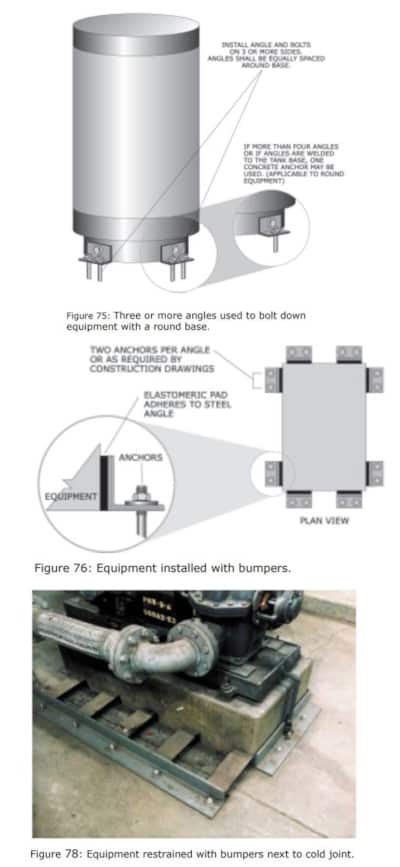
In an earthquake, equipment sitting on a surface (no matter how heavy) can shake, wobble, and tip over. The hangers for suspended equipment can experience significant stress during an earthquake because of shaking, and the equipment itself may deform, collide with other objects, or fall from its mounting point. To prevent damage—by ensuring that the equipment moves with the building during an earthquake and can’t shift or tip over—seismic bracing is necessary. As FEMA 412 and FEMA 413 explain, this can involve:
- Bolting equipment directly to structural members
- Using steel shapes to fix equipment to the structure, or
- Using bumpers to prevent the equipment from moving (when there is no risk of the equipment tipping over.
Vibration isolation systems may also be used to dampen the effects of shaking on equipment. These commonly take the form of heavy-duty springs.
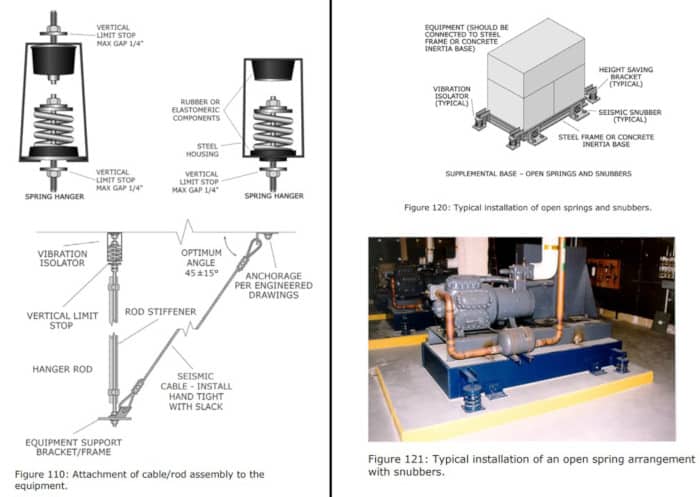
Conduits need seismic bracing assemblies
Conduits, including HVAC ductwork, piping, and electrical conduits and raceways, may also require seismic bracing. ASCE 7 says that:
- HVAC ductwork needs bracing when the duct has a cross-section 6 ft. or larger or when it weighs more than 17 pounds per linear foot, or when it has an Ip=1.5.
- Electrical raceways need bracing when they are 5” trade size or bigger. Also, all trapeze-supported raceways weighing 10 pounds per linear foot or more need braces. Electrical components with Ip>1.0 need seismic protection.
- As we’ll explain later, non-sprinkler piping systems may or may not need bracing, depending on whether they are high-pressure systems or convey hazardous materials.
Any system, whether it meets these specific requirements or not, needs seismic bracing in Occupancy Category IV buildings, where the failure of a system renders the building unusable.
When ductwork, electrical conduits, and piping are hung from the ceiling (whether by rods or trapeze supports), seismic bracing is used to resist horizontal forces. The bracing protects the equipment and its hangers (often threaded rods or trapeze supports) from lateral (perpendicular to the run of the conduit) and longitudinal (parallel to the run of the conduit) shaking.
Seismic bracing in these cases consists of tension-based cable braces or rigid steel braces.
Cable seismic braces link part of the conduit system to a structural member. To resist motion in two directions, opposing cable braces are needed.
Rigid steel braces perform the same job as cable braces, but only one length of steel is needed. Rigid braces are, however, limited in length, and they won’t fit in certain areas and set-ups. Thus, cable braces are a far more flexible option, as they can be used just about anywhere. FEMA 412 also shows cable and rigid bracing used in conjunction with rod stiffeners and vibration isolation systems.
You can learn about the principles and technologies of seismic bracing in our article on bracing for fire sprinkler systems. For more information on specific design considerations (including load calculations) for seismic bracing, check out our other blog on the subject. Keep in mind, though, that the specific requirements and calculations for fire sprinkler systems are dictated by the National Fire Protection Association (NFPA); other systems have different requirements and standards.
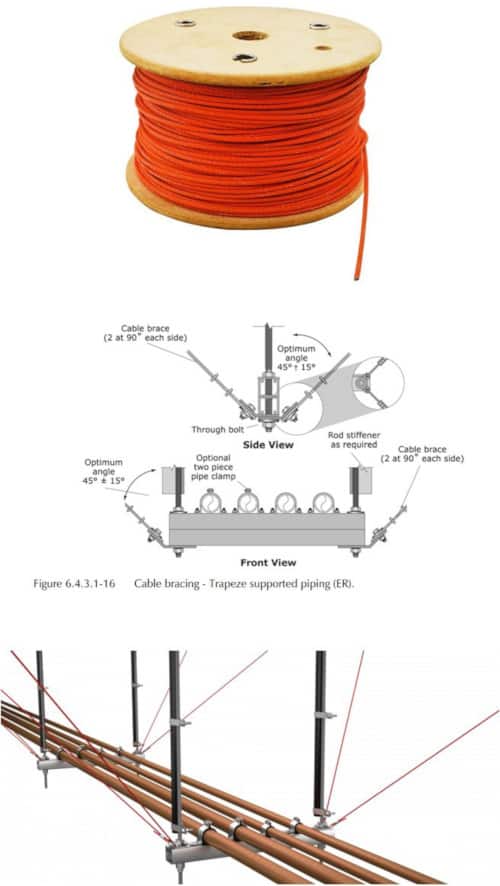
A note on flexibility
Seismic bracing is not the only element of seismic design. When different floors or wings of a building (or two independent buildings with shared utilities) move differentially (relative to one another), it can cause damage to conduit materials passing through the joints. The same problem can arise when a piece of equipment—e.g., a boiler or fan—is braced to the structure. Conduit materials—piping, ducting, etc.—connected to that equipment can experience stress from this differential movement.
In any of these cases, flexible design may be necessary. The techniques of flexible design for all kinds of MEP-F equipment are outside the scope of this article, but you can read more about the principles in our piece on flexible protections for fire sprinkler pipe.
Special considerations for MEP bracing
HVAC, electrical systems, and piping each have some unique challenges that must be taken into account when designing seismic protections.
Seismic bracing HVAC systems: Considerations for equipment in-line with ducting
For the most part, heavy HVAC equipment and ducting are distinct, though linked, equipment. However, ducting may be connected to in-line heavy equipment (fans, humidifiers, etc.). ASCE 7 (section 13.6.7) requires equipment weighing 75 pounds or more that is installed in-line with ducts to be laterally braced independently of the ducts. In other words, such equipment needs dedicated bracing—duct bracing cannot do double-duty.
Seismic bracing electrical systems: Considerations for heavy equipment
Electrical components with an Ip factor greater than 1.0 must be protected against seismic forces, according to ASCE 7 (section 13.6.4). Heavy electrical equipment, as FEMA 412 shows, can be secured against movement in much the same way that HVAC equipment can. However, ASCE 7 (section 13.6.4) mentions some special protections needed for electrical equipment, including the following:
- Batteries on racks need wrap-around restraints to keep them from falling
- Drawers and other slide-out mechanisms should be latched
- The internal coils in dry-type transformers must be secured to their supporting structure
Seismic bracing for pipes: Considerations for different kinds of piping
Pipe networks may require seismic protection. Besides water, pipes transport many substances throughout buildings, especially in industrial and healthcare settings. These substances can be under high pressure (15 pounds per square inch or more) or not under high pressure (less than 15 psi). They also may or may not convey hazardous materials (toxic, flammable, explosive, etc.) that require containment.
As explained by Reducing the Risks of Nonstructural Earthquake Damage – A Practical Guide (FEMA E-74), HAZMAT piping has Ip=1.5 and requires seismic protection. Pressure piping requires bracing.
The failure of non-HAZMAT, non-pressure piping mainly threatens property, so it may be exempt from seismic protection requirements—but not necessarily. One case where non-pressure pipe needs protection is piping in Occupancy Category IV buildings, where the failure of water lines, for instance, renders the building unusable.
Seismic bracing for heavy pipe components
The main complications in applying braces to pipe are in-line pumps and valves (such as large cast-iron valves) in high-pressure systems. These components can be very heavy, and FEMA E-74 gives a few special requirements for their protection:
- Load calculations for suspended in-line pumps must be performed with ASCE 7 coefficients for pumps, not pipes.
- Suspended in-line pumps must be hung independently of the piping.
- Pumps must have their own seismic bracing. The only exception to this rule is if the pumps are less than 20 pounds operational weight, and the piping has Ip=1.0.
- Valves over 20 pounds must have individual seismic bracing.
- Valves under 20 pounds must have their own seismic bracing unless the piping has Ip=1.0.
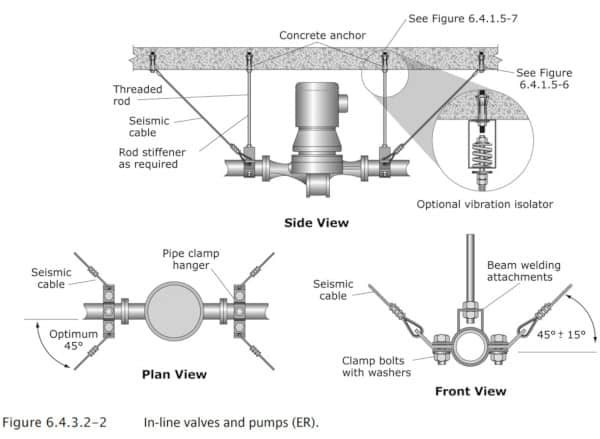
Seismic bracing for ductwork, heavy HVAC equipment, electrical systems, and pipe is complicated
HVAC, electrical, and piping systems may need seismic protection if a building is in a specific seismic design category, and ASCE assigns the equipment a high importance factor (Ip). The failure of these systems in an earthquake can mean huge financial costs, not to mention the loss of life. The basics of seismic protection are simple:
- When something shouldn’t move, bolt it down or secure it with braces. Vibration dampeners and rod stiffeners are useful, too.
- Where things need to move to avoid damage, make them flexible.
The specifics, though, are very complicated. You need to calculate the seismic loads, expected displacement, the strength of your braces cable or members, the number and placement of the braces, the limits of the hardware, the strength of the structure, and more.
Many industry standards and codes govern seismic protection for nonstructural components. ASCE 7, the International Building Code (IBC), and various FEMA publications have already been named. Beyond these, you may need to refer to:
- ANSI/AHRI Standard 1270 (I-P) Requirements for Seismic Qualification of HVACR Equipment (2015 edition) from the Air Conditioning, Heating, and Refrigeration Institute (AHRI) and American National Standards Institute (ANSI)
- Seismic Restraint Manual Guidelines for Mechanical Systems, a publication of ANSI and the Sheet Metal and Air Conditioning Contractors’’ National Association (SMACNA)
- Guidelines for Seismic Restraint for Direct-hung Suspended Ceiling Assemblies, a publication of the Ceiling and Interior Systems Construction Association (CISCA)
- Process Piping (ASME B31.3), a publication of the American Society of Mechanical Engineers (ASME)
Other standards and documents may apply. Local building codes and authorities having jurisdiction will have the final say on which standards, listing requirements, and other mandates may apply.
Make sure to consult with your AHJ—often, the local building department—to verify how much protection is required in a structure.
This blog was originally posted at blog.qrfs.com. If this article helped you, check us out at Facebook.com/QuickResponseFireSupply or on Twitter @QuickResponseFS.


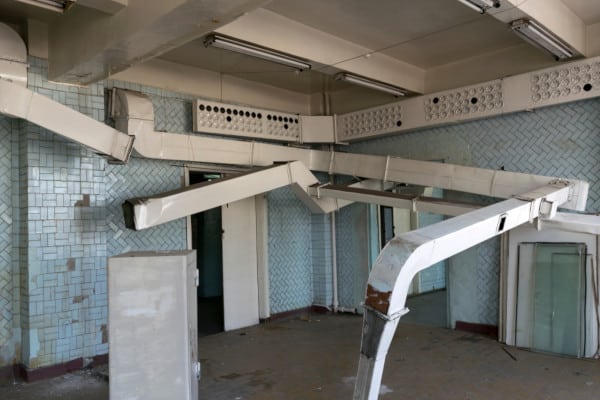
Dear Sir,
We need Seismic bracing for our control relay panels , can you suggest types of bracing which can be used in our control panels and what will be the cost per meter for the same.
Virender — thank you for reaching out. We will have someone from our QRFS Customer Support Team contact you.
We are looking for some product/info on seismic bracing on commercial cooking hoods in St. Louis.
Andrew — QRFS has some seismic bracing cables and accessories left in stock. Otherwise, we suggest you engage a qualified fire protection design professional to assess what you specifically need for commercial cooking applications— and feel free to email support@qrfs.com with any specific questions about our available products!
Working on Sway Braces for Round Ducts.
Need help..
Anupam — Please be specific about what you would need; although, your best bet for specific installation questions is to contact the manufacturer of the braces or a local fire protection pro!
Do we use ASCE 7-10 or ASCE 7-16 for Seismic Bracing of Fire Sprinkler Piping?
George — Please reference the detailed rules in Chapter 18 of NFPA 13: Standard for the Installation of Fire Sprinkler Systems.
I was taught that piping less than 2 1/2″, with the exception of medical gas piping, does not need seismic bracing. In the case of medical gas, the size I was told was anything smaller than 1 1/4″ did not need bracing. With these standards, was I taught correctly?
Michelle — We’d have to dig into this to provide a truly helpful answer. However, we quickly looked around and found specific mentions of an exception for “Gas and medical piping less than 2-1/2 inches inside diameter” in Veterans Administration and FEMA documents that otherwise say “follow the International Building Code,” which indicate specfific federal requirements/standards/exceptions. The question is whether these references are in the ICC codes or specific state codes. If you’d like, you can use our Ask a Pro service, where a fire protection pro will gather information on your specific situation and provide a well-researched answer. Another option is to contact your specific authority having jurisdiction (which may be the federal government), review seismic design requirements in those applicable jurisdictional codes, and likely check out ASCE 7, which both NFPA and ICC codes and standards (among other codes and regulations) largely defer to on many seismic design specifics. Thanks for reading!
Thank you so much for responding. I will add that these exemptions can be found in Chapter 13 of ASCE7-10. Shortly after posting this question I was provided with a copy of this entire chapter. I appreciate your response and willingness to help. I sincerely hope this helps others out there!